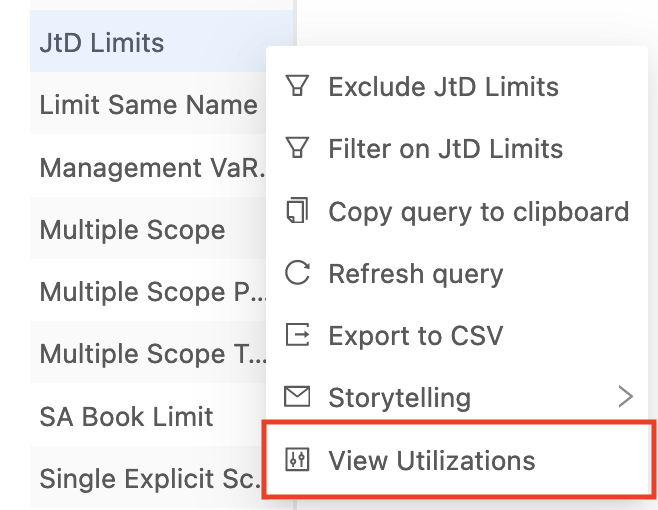Limits Inventory
The Limits Inventory widget is where you can view and create new limit definitions.
To access the widget, click and drag its icon from the top menu bar onto your dashboard:
![]()
The Widget contains a table of limit definitions and three buttons:

Widget buttons
- Create New Limit: Opens a form where you can enter and select information for your new limits definition.
- Upload: Allows you to add new limits to the widget’s table by specifying a CSV file from files on your local machine.
- Download: Exports the table from the widget into a CSV file. All limits are exported, regardless of any filters applied.
Context Menu Actions
View Utilizations
This action lets you investigate the utilization of limits.

To help investigate exceptions, for each limit, a link can be made to a dashboard in the Business Cube. The link from the limit name to the Business Cube dashboard is defined in a configuration file. If the association is defined, clicking View utilizations will display the associated dashboard.
For example, a dashboard builder may create a dashboard called “JTD Limits Utilization” for investigation. You can then configure the Limits Module to establish a link between this dashboard and “JTD Limits”. As a result, right-clicking the relevant row in the Limits Inventory widget, then selecting View Utilizations would display the “JTD Limits Utilization” dashboard.
For details on this configuration setting, see limits_plugin-table-view-utilizations.settings in Configuring the LimitsSettings.ts file.
Table columns
note
The number and order of columns in the Limits Inventory Widget table differ from the input CSV file. You can still upload an input CSV file despite differences in columns and order.
| Field Name | Description | Example |
|---|---|---|
| Group | Name of a group of limits. Group is a way of grouping similar limits. | Equity Desk |
| Name | The KPI name created in the business cube. | SA Desk Limit |
| Start Date | Effective start date. | 2018-09-28 |
| End Date | Effective end date | 2020-01-01 |
| Server Name | The server where the limit is created. | MRA |
| Cube Name | Name of the business cube for the KPI/Limit. | Sensitivity Cube |
| Measure Name | Measure of the KPI. | FX Risk Charge |
| Scope | This determines which members the new limit applies to. The scope is made up of any level of the currently selected cube and a corresponding value from said level. An example scope filter is “Desk=Rates”. One limit definition can have multiple scope filters. Every scope filter is separated by a pipe. | Desk=Bonds |
| KPI Type | The KPI type. For details, see Select a rule. | Greater Than |
| AbsoluteValueIndicator | Specifies whether the limit value is an absolute value. | false |
| Workflow Status | Status of a limit’s workflow. | APPROVED |
| Actions | Limit operations you can execute. The available operations are: * View: View and edit (if permissioned) the limit’s full definition. The inventory table displays a subset of the full limit definition. * Copy: An easy way to create new limits by duplicating existing ones. This button opens up the Limits Drawer with all of the fields filled in. * Delete: Removes the limit and associated KPIs from the table. |
View Copy Delete |